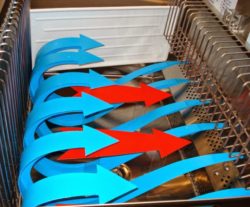 Continuous motion washing is defined as full submersion ware washing utilizing heated water, detergent and agitation without a fixed cycle time. But how does it work in a real-world commercial kitchen application, and is it worth the equipment investment? This blog will answer those questions by boiling the subject down to the basics.
Continuous motion washing is defined as full submersion ware washing utilizing heated water, detergent and agitation without a fixed cycle time. But how does it work in a real-world commercial kitchen application, and is it worth the equipment investment? This blog will answer those questions by boiling the subject down to the basics.
Operational Fundamentals
One way of looking at a continuous motion commercial ware washing system would be to consider it as an additional staff member that can be trusted with tough washing and scrubbing tasks. Since the soils on pots and pans vary widely, there is typically no set cycle time. Rather, the employees assisting with pot and pan washing simply need to remove, rinse and sanitize clean items when their schedule permits. If an item is not 100% clean, the employee can either quickly finish it off with minimal effort or simply drop it back in and get it on the next stop.
This is why one of the training messages for a continuous motion commercial ware washing system is, “You just need to get the pots and pans to it and through it. The system will do the tough scrubbing and washing work.” Still, some of the newer systems on the market incorporate “batch washing” processes and alert systems. These are typically used in commercial foodservice operations where pot and pan washing is a “shared function.” The batch washing alert system lets any employee or manager know when all of the items in the system should be 100% clean and ready to rinse and sanitize.
System Design and Performance Fundamentals
Revisiting the definition of continuous motion washing, heated water and detergents are givens, but the agitation is where the commercial ware washing systems on the market differ from each other. This is where the “Three R’s” of continuous motion ware washing come in: Rotate, Reposition and Represent. Items must be rotated and kept moving freely in the system to become completely clean and sanitized. To optimize washing, ware items must naturally and freely reposition as they rotate in the system. Finally, ware items must consistently and repeatedly represent in front of the wash jets so loose soils can be effectively stripped away.
It is critical to remember that in a continuous motion washing application, the loose (un-racked) ware items must be rotated through the stationary wash jets. This is the exact opposite of spray washing, where rotating wash jets are moved through stationary (racked) ware items. Many pot washer systems try to rotate mostly square or rectangular ware items in a circle in a rectangular tank. With longer distances for the wash water to travel and gravity working against them, ware items tend to pile up or “log-jam” in the system. This can result in ware items covering and restricting the pump intake and not being properly washed.
Look for systems that rotate the ware items vertically from an end view of the wash tank, like the Power Soak. This system lifts the ware items up toward the front of the tank, and then the current carries them toward the rear of the tank where gravity drops them back through the wash jets. Ware items continuously rotate, reposition and represent so washing is even and fast. In addition, the Power Soak system outshines other systems from an ergonomic standpoint as well as gentle washing action.
On these last two notes, there is much more to discuss and consider. We will continue to cover key facets of continuous motion washing in the next Power Soak blog. If you can’t wait that long, visit our Power Soak ware washing section to learn more now!